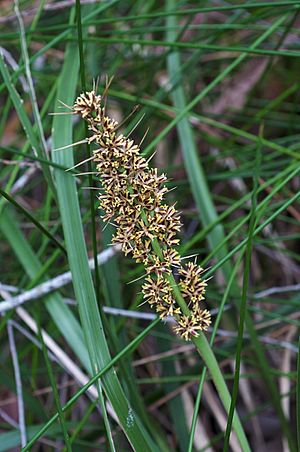Spiny-head mat-rush facts for kids
Quick facts for kids Spiny-head mat-rush |
|
|---|---|
 |
|
| Scientific classification | |
| Synonyms | |
|
Xerotes longifolia (Labill.) R.Br. |
Lomandra longifolia, also known as spiny-head mat-rush or basket grass, is a tough plant found all over eastern Australia. It's a type of herb that lives for many years and spreads using underground stems. Its leaves are long and thin, usually about 40 to 80 centimeters long and 8 to 12 millimeters wide. This plant can grow in many different kinds of soil. It's also very strong, able to handle cold frosts, hot weather, and dry periods without much water. A scientist named Labillardiere first described this plant from a sample he found in Tasmania.
Contents
A Tough Plant for Many Places
This plant with its long, strap-like leaves is often used along roadsides. You can find it in Australia, New Zealand, Spain, and the United States. It's popular because it can survive long periods without much rain.
Popular in Gardens
Over time, people have grown new types of Lomandra longifolia. These new types have finer, more compact leaves. This has made the plant very popular for home gardens. It stays green all year round, looking like a type of grass.
The Tanika Variety
One very popular type is called Tanika, or Lomandra longifolia 'LM300'. In the US, it's also known as breeze grass. This was the first type with very fine leaves. Its leaves are only about 3 millimeters wide, making them the thinnest of all Lomandra longifolia plants.
Surviving the Cold
Tanika plants can stay green even when temperatures drop to about -7 degrees Celsius. Some have even survived in places like Alabama, USA, where it got as cold as -10 degrees Celsius. This shows how strong and adaptable these plants are.
Traditional Uses of Basket Grass
For a very long time, Indigenous Australians have used Lomandra longifolia in many ways.
Food and Water
They would grind the seeds of the plant into a flour. This flour was then used to make a type of bread called damper. The base of the leaves holds water. People who were very thirsty or in danger of dehydration would chew on these leaf bases to get water.
Weaving and Crafts
The long, flat, and strong leaves of the plant were also very useful. Indigenous Australians used these fibrous leaves for weaving. They made things like baskets, mats, and other useful items. This is why one of its common names is "basket grass."
How It's Different from Similar Plants
Lomandra longifolia is closely related to another plant called Lomandra hystrix. They look quite similar, but there's a key difference in their leaves.
Leaf Shape Differences
If you look closely at the end of a Lomandra hystrix leaf, you'll see small teeth on each side of the main point. For Lomandra longifolia, the side teeth at the end of the leaf are usually as long as or even longer than the central point. This gives the leaf tip a "W" shape. This small detail helps tell the two plants apart.

